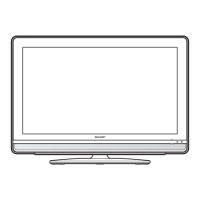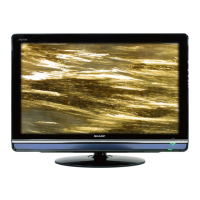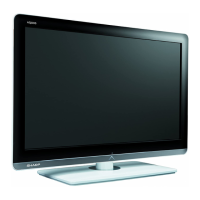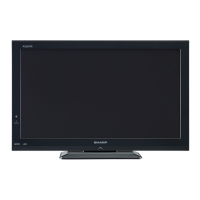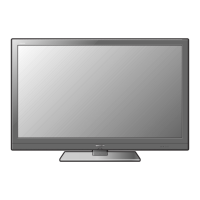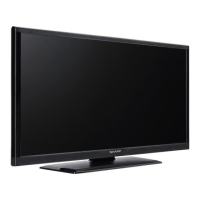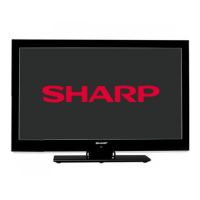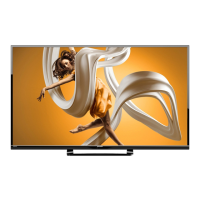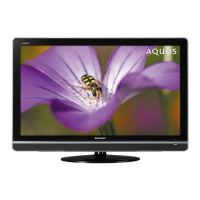
Do you have a question about the Sharp LC-32L450X and is the answer not in the manual?
Covers cleaning, water proximity, ventilation, heat sources, and fire prevention for safe operation.
Addresses stand stability, furniture safety, and risks associated with children climbing.
Guidelines for safely moving and transporting the TV, emphasizing proper handling.
Notes on static images causing afterimages and the behaviour of pixels on the LCD panel.
Step-by-step instructions for attaching the TV stand, including screws and screen rotation.
Essential steps to take before attaching or detaching the TV stand for safety.
Connects the antenna cable and AC power cord to the TV for reception and power.
Guides for connecting VCR, game consoles, DVD players, PCs, and other audiovisual equipment.
Instructions for outputting audio via the digital audio output terminal.
Details the purpose and operation of various buttons on the remote control.
Instructions for inserting the battery into the remote control unit.
Identifies key components and connectors on the front and rear panels of the TV.
Explains the power indicator status and proper usage of the headphone jack.
Covers turning the TV on/off and switching between operational and standby modes.
Procedure for supplying power to the antenna to ensure proper DTV reception.
Guides through the initial setup process, including country and channel selection.
Verifies signal strength and quality for optimal antenna alignment during setup.
Displays signal strength and quality values to aid antenna alignment.
Allows re-running the channel scan and setup process for preset channels.
Adjusts digital services, including manual search and service-specific settings.
Features for sorting, auto-searching, and manually adjusting analogue channels.
Erasing individual analogue channels and managing their order for better organization.
Choosing viewing modes like Standard, Movie, Game, PC, User, Dynamic for optimal picture/sound.
General instructions on navigating the TV's menu system using buttons and the ENTER key.
Controls for Backlight, Contrast, Brightness, Colour, Tint, Sharpness, and Advanced settings.
Explains OPC, Active Contrast, DNR, 3D-Y/C, Monochrome, Quick Shoot, and Film Mode.
Controls for Treble, Bass, and Balance settings to fine-tune audio output.
Details SRS TruSurround HD™ and Bass Enhancer functionality for immersive sound.
Manages power saving through No Signal Off, Power Management, No Operation Off, and Ecology modes.
Accesses Auto Installation, Analogue/Digital Programme Setup, Input Skip, and Position settings.
Protects settings with a password and provides procedures for setting/clearing it.
Restricts channels based on age ratings for different countries to prevent inappropriate viewing.
Assigns input labels, adjusts image position, and configures HDMI auto view/WSS.
Selects input source, PC audio, output volume, auto volume, and clear voice.
Configures digital audio output, game time display, and DivX registration.
Fine-tunes PC image display using auto sync, manual adjustments, and input signal settings.
Selects audio languages, subtitle languages, and hearing-impaired subtitles.
Configures time zone, summer time, and automatic software updates (OAD).
Displays DTV schedules, allows searching, and setting programme reminders.
Shows detailed information about current DTV programmes.
Guides DTV auto search and analogue auto installation procedures.
Selects stereo, bilingual, or monaural audio modes for analogue broadcasts.
Explains how to switch audio modes for different broadcast types.
Viewing the EPG, managing reminder schedules, and cancelling timers.
Freezes a motion picture on the screen for static viewing.
Options to adjust the picture aspect ratio for optimal viewing.
Viewing and cancelling EPG reminders.
Manually choosing picture sizes like Normal, Zoom, Panorama, Full, Cinema, Dot by Dot, Underscan.
How to turn Teletext on/off and use its various button functions.
Details communication conditions and procedures for controlling the TV via PC.
Lists resolutions and frequencies supported for PC input.
Provides a list of commands for controlling the TV via RS-232C interface.
Guides on connecting USB devices and accessing photos, music, and videos.
Choosing between Photo, Music, and Movie modes for USB content.
Navigating folders, selecting videos, and controlling playback with various buttons.
Selecting and playing music files, controlling playback.
Selecting photos, viewing thumbnails, and full-screen viewing with rotation.
Details DivX registration code, VOD, and deactivation procedures.
Lists compatible file extensions, containers, and codecs for USB playback.
Provides solutions for problems like no power, picture, or sound issues.
Advises on operating the TV in temperature extremes and avoiding damage.
Lists LCD panel, resolution, colour system, terminals, power, dimensions, and weight.
Highlights differences in panel, resolution, and dimensions between models.
Information on available optional accessories like wall mount brackets.
Instructions for anchoring the TV to a wall or fixing it securely to a table.
Visual representations of TV dimensions and layout for different models.
Procedure to reset or clear the Child Lock password if it has been forgotten.
